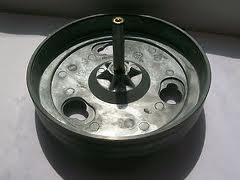The floating subchassis and belt-driven Thorens, despite being models from the 1970s, can still have their say today. Some think they are overrated compared to their more high-tech contemporaries such as Technics and other Japanese brands. Others believe that even today it is difficult to approach their performance without spending considerable sums. The main reason would be precisely the suspended subchassis, a system that is nowadays adopted on quite expensive turntables. The rigid chassis goes for the most, then the drive can be belt-driven or direct. A 1970s Thorens no longer come cheap, and you have to know what to check before you buy it.
Let’s say a newly purchased Thorens definitely needs belt and cartridge stylus replacement if not the whole cartridge, if any. Most likely the RCA connectors of the two phono cables need to be replaced. It is good also to clean and oil the subplatter pivot well. At this point it is ready to work. A good upgrade would be a mat such as the Funk Firm Achromat, but given the cost you can wash and keep the original rubber mat or create your own made of cork or vibration damping material. The rubber feet can be improved with something larger and more stable, the lower plywood panel eliminated or replaced with MDF. The frame can be dampened with adhesive sheets of vibration-absorbing material. The possibilities for improvement are many.
For many years my analogue source had been a Thorens TD-165, the bottom level model of the German manufacturer in the 70s. Since May 2015, I’ve upgrade it with its bigger brother, the wonderful and acclaimed TD-160, which I happened to find at a price I couldn’t refuse. The following November I stumbled upon an even better TD-160 bargain, still MK1 but a more recent built.
Nonetheless, I sadly gave away my TD-165 (but to a friend I was sure would have cared for it as it deserved). I’d been using that turntable for a dozen years, I had learned a lot about tuning up this kind of TTs, typical suspended (floating subchassis) belt-driven tables. Internet is an incredible source at that, you just need to now some written English. This is not my problem so, because of the different time zones, I received advices from Australia in the morning, UK during the day, North America at night.

Underside of a Thorens TD 160 turntable – from theanalogdept.com
Following those advices, I removed its feet and bottom board and put my adopted Thorens upside down on a table. I’ve never mounted them back since it appears the thin wooden bottom board and the insignificant small rubber feet are more an issue than anything. At those times our little one was just 4 months old. I waited for him and my wife to go to bed and then I started to work. The following night I applied the advices and suggestions I received from the Internet forums. It’s been a lot of fun. This kind of turntables, like those from Linn, AR and others, are based on a suspension system called floating-subchassis (image below from theanalogdept.com): in red color the subchassis, a metallic layer of vaguely triangular shape (picture above – an upturned Thorens, also from theanalogdept.com), which holds both tonearm and inner platter or subplatter (yellow).

Inside of a Thorens TD 160 – theanalogdept.com
The latter is the rotating base upon which the outer platter rests (grey in the picture above); it is connected to the motor (violet, the spindle is green) by means of a rubber belt. The subchassis+outer platter+subplatter system is decoupled from the top plate by means of three springs (blue in the image, indicated by red arrows in the first picture above). Once the outer platter is removed, we can see the subplatter with its bearing shaft at the center and the belt connecting it to the motor spindle.
If the belt is old we can just trash it and install a new one – otherwise it can be cleaned with alcohol and then dusted with talc powder for rinsing (even better if we use lattice gloves while at it). By removing the subplatter we can check its bearing shaft’s conditions (at left, the TD-150 zinc subplatter). The shaft is inserted in the vertical housing or well that we can see in the upturned Thorens picture (the small vertical cylinder in the middle of the subchassis). The shaft must not show any scratches or abrasions and has to be oiled properly so it can spin fluidly with no noise or rumble. There are several choices for lubricating oils. Those for sewing machines or for lubricating guns is ok. Alternately, it seems Thorens just used SAE 20W turbine oil.
An infinite thank you to the audiokarma.org guys, who helped me so nicely through my adjustments and fine tunings of the splendid Thorens I “adopted”. Without them it would have been impossible! You can see by yourself from the links below.
Tuning tonearm suspension bearings on rudi-zampa.at
Esposing the VTA myth, by Geoff Husband on tnt-audio.com
How to adjust a Thorens on theanalogdept.com
The Thorens pahe on theanalogdept.com
Restoring Thorens TTs on vinylnirvana.com
audiokarma.org forum thread about Thorens suspensions
audiokarma.org forum thread about VTA
